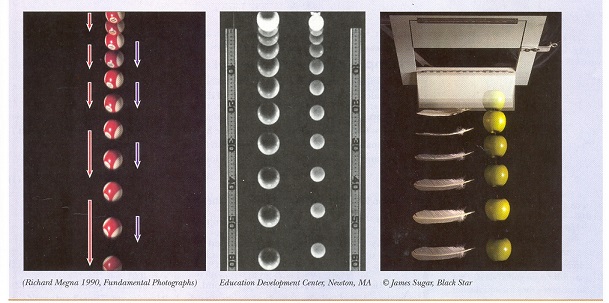Assignment:
On the center photo measure the distance between the two images nearest the 20 cm position of the larger, heavier ball on the left. Use bottom to bottom measurements as shown in a previous figure.
Repeat for the two images nearest the bottom left of the photo. Scale these distances to actual displacements by multiplying the photo distances by the appropriate scale factor determined in Part A.
Calculate the two velocities corresponding to the scaled displacements by dividing each displacement, actual, in meters by the image time interval, 1/30 s.
Now calculate the acceleration of gravity from the change in velocity divided by the total time between the two pairs of images. The equation is g = (voy-vy)/t from the above equation list. The total time is determined from the number of spaces between images. Count the first space (roughly between the 19 and 20 cm marks) as the zero for the starting point, the next space as one, and continuing to the last interval that occurs between the 50 and 60 cm marks. Each space is again worth 1/30 s.
Compare the value of g determined experimentally with the known value of 9.8 m/s2 by taking the difference between the two numbers then dividing by the known value and multiplying by 100.
% difference = (gexp -9.8)/9.8 x 100
Round this % to 1 1/2 digits for percents less than 20 % (one digit unless the first significant figure is 1 then use two digits). Examples 0.013 %, 0.7 %, 1.8 %, 4 %, 19%. For % greater than 20 % use two digits. Example 37 %.
